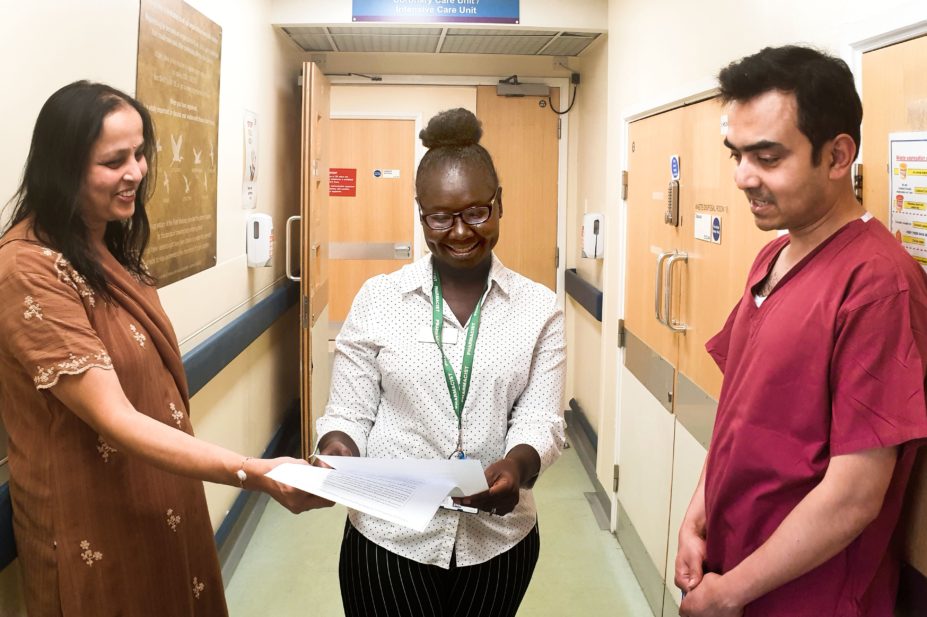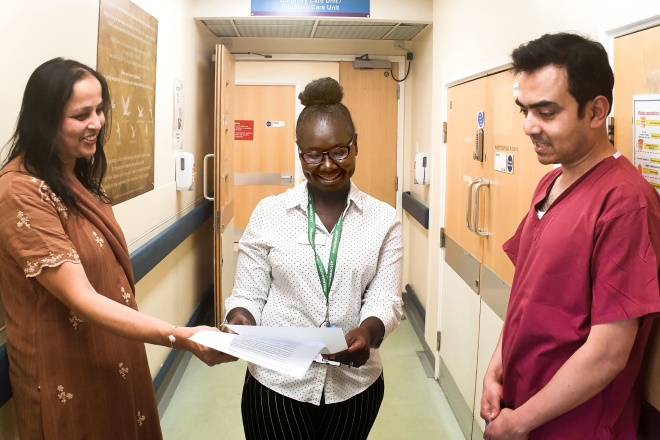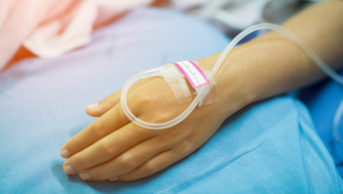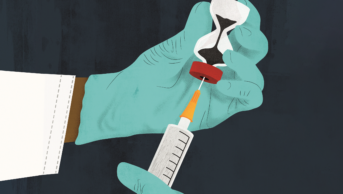
Sandra Sowah
Open access article
The Royal Pharmaceutical Society has made this article free to access in order to help healthcare professionals stay informed about an issue of national importance.
To learn more about coronavirus, please visit: https://www.rpharms.com/resources/pharmacy-guides/wuhan-novel-coronavirus

Source: Sandra Sowah
Being able to handle complex clinical queries in a high-pressure environment makes specialist pharmacists an essential part of the critical care multidisciplinary team, says principal pharmacist Sandra Sowah; pictured centre with two consultant intensivists
I joined Medway NHS Foundation Trust in 2016 as a rotational pharmacist. I had never previously considered critical care as a potential specialty, but four months after completing a nine-month critical care rotation, an opportunity to become a band 7 senior critical care pharmacist presented itself.
The thought of providing a clinical pharmacy service to critically ill patients both terrified and excited me. Following this, in September 2018, I was offered a position as a principal critical care and surgery pharmacist.
As a critical care pharmacist, I play a vital function in the management of safe and effective use of medicines for patients who are critically ill or who have life-threatening conditions. I am an important member of the multidisciplinary team (MDT), offering professional advice and guidance on prescribing, dosing and administration of highly specialised medicines.
Critical care, especially during the COVID-19 pandemic, is physically and emotionally challenging. It is certainly difficult witnessing patients fight for their lives: it requires resilience as both the patient’s condition and the environment are constantly changing at a rapid pace. The pandemic has given hospital pharmacists — especially critical care pharmacists — a unique opportunity for valuable learning and team working. Being proactive, rather than reactive, has been essential to ensuring patient safety and continuity of care.
08:30 — start
A typical day at the hospital starts by checking emails to help me prioritise tasks.
I respond to the most urgent query relating to a shortage of critical medicines required for the unit. There has been a nationwide shortage of sedatives, especially propofol 1% and 2%, as a result of the pandemic, and it has been important to monitor stock on a daily basis. Monitoring prescribing patterns of propofol, remifentanil, morphine and midazolam infusions allows us to ascertain how long our current stock will last and plan to ensure adequate stock levels during times of increased demand. As a critical care pharmacist, I am regularly making decisions that have severe consequences, so the last thing I want is to unexpectedly run out of critical medicines.
I schedule other duties for the day, such as teaching and meetings, in the afternoon where possible.
09:00
I join the critical care ward round where I am required to wear full personal protective equipment when reviewing patients.
The format and duration will vary depending on bed occupancy and which consultant intensive care physician is leading the team. Each member of the team (e.g. registrar, pharmacist, dietitian, physiotherapist etc.) has an opportunity to speak about each patient if they have an opinion on therapy, so I make sure to check my patients’ electronic charts and review their medicines prior to the round. I consider observations (e.g. laboratory results), any adverse drug interactions, ensure appropriate dosing of the right treatments and confirm appropriate antimicrobial therapies.
10:30
During the ward round, I was asked about starting an infusion of iloprost, a platelet aggregation inhibitor and vasodilator, for a vascular patient. However, as there is a national shortage of this product, I suggest discussing use of an alternative — epoprostenol. This is not the first-line option for peripheral vascular disease in our trust, but I have experience of this from my local network of critical care colleagues.
I am approached by an intensive care unit (ICU) nurse who has a query about a patient with sepsis who has a central line in situ, but requires the administration of three medications. I advise them on how to avoid potential mixing of incompatible drugs by explaining which of the drugs can be mixed, which can be administered as a bolus and which via a Y-site connection.
11:45
Just as the ward round ends, I receive another query from a nurse about a prescription that needs to be amended in order to administer the medication.
I speak to one of the doctors to advise them of the appropriate dosing information and have the prescription amended. Being able to handle complex clinical queries such as these in a high-pressure environment makes specialist pharmacists an essential part of the critical care MDT.
12:00
I have a list of jobs to complete after the ward round, which typically consists of answering medicine-related queries. For example, speaking to a patient’s family and GP to clarify a penicillin allergy, which turns out to be a gastrointestinal side effect. This means they can be prescribed penicillin-based antimicrobial therapies, such as piperacillin/tazobactam or co-amoxiclav. I make a note of this in the patient’s electronic file.
I also make an urgent critical medicines order request for patients running low on their supply.
13:00
I have lunch with my other pharmacist colleagues and then take a short walk outside to give myself a mental break and prepare myself for the second half of the day.
14:00
I review several electronic prescriptions from my desk, particularly those which I did not have the chance to review fully during the ward round.
I then follow up on requests and orders for critical medicines I made earlier and catch up with the antimicrobial pharmacist to discuss any changes to antimicrobial therapy that occurred during the microbiology ward round, as I was unable to join today.
We discuss the use of a restricted antibiotic, linezolid, which has been prescribed for a patient transferred from the emergency department to ICU. We agree that there is no clear clinical indication or rationale for this prescription, and I make a note to follow this up with the doctors.
15:00
I head back to the ICU to discuss prescription amendments, duplication of prescriptions and other medicine-related queries discussed during the morning ward round that have not yet been actioned by the medical team.
I stop by newly admitted patients to review their intravenous pumps, assess their condition and check with the nurses if any medicines are required.
16:00
Towards the end of the day I update my clinical records and check my emails, responding to any that are urgent.
17:30 — finish
My day usually wraps up by 17:00, but today I am running the warfarin clinic and need to stay longer. I consult with new patients starting on warfarin, along with existing patients. I review and monitor their international normalised ratios, adjust warfarin dosages accordingly, and provide advice and education.
Being a critical care pharmacist with other duties and responsibilities can be challenging but rewarding.
Critical care pharmacists are vital in helping to manage patients with multi-organ failure who have complex needs and the team I work with in critical care has shown that they appreciate my expertise.
What amazes me is the resilience of the whole MDT — how we have pulled together and collaborated during the COVID-19 pandemic to work in the best interests of our patients. I am confident that this flexible, multidisciplinary approach will continue beyond the pandemic.
Box: Are you interested in a similar role?
- My role is NHS Agenda for Change band 8A;
- Apply for a rotational pharmacist role in a hospital and be prepared to work your way up from a band 6 position;
- A post-graduate clinical diploma qualification with an independent prescribing element is essential. I strongly believe this is the way forward for clinical pharmacists to progress;
- Join the UK Clinical Pharmacy Association and the Royal Pharmaceutical Society Faculty Programme — both of which are great places for learning, networking and mentorship;
- Be prepared to work on areas that require improvement and to continually push yourself;
- Ask to shadow people in similar roles and expand on your knowledge base and skill sets;
- Do not give up when obstacles are placed in your way — be resilient in the face of adversity.


